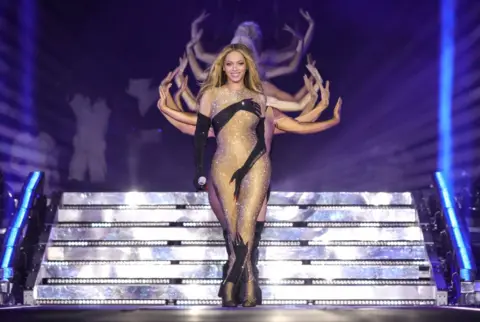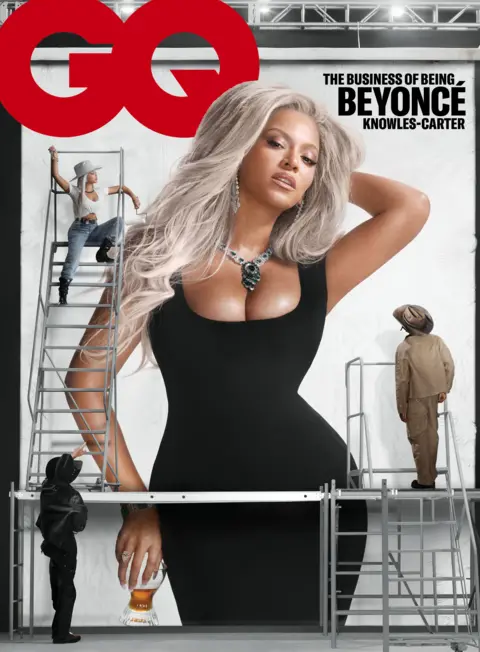Beyoncé explains why she stopped making videos
 Parkwood / Columbia
Parkwood / ColumbiaFrom the moment she blew bubblegum in Crazy In Love to the day she destroyed a fleet of cars with a baseball bat in Hold Up, Beyoncé has created some of pop's most memorable music videos.
Her mastery of the medium matched that of Madonna and Michael Jackson in the 1980s - with the videos for her Lemonade album acting as a powerful celebration of black womanhood and female power.
Then, all of a sudden, she stopped. Her last two albums, Renaissance and Cowboy Carter, have been bereft of visuals, leaving fans perplexed.
Now, Beyoncé has explained her decision in a rare interview with GQ magazine, saying she didn't want her videos to become a "distraction from the quality of the voice and the music".
"I thought it was important that during a time where all we see is visuals, that the world can focus on the voice," the star said.
She explained that her recent records - which seek to contextualise black musicians' often overlooked contributions to genres like house, disco and country - needed to stand on their own.
"The music is so rich in history and instrumentation. It takes months to digest, research, and understand," she said.
"The music needed space to breathe on its own."
She added that, for Renaissance in particular, the live concert experience was more important than filming music videos.
The album, released in 2022, was written during the pandemic and was conceived as "a place to dream and to find escape during a scary time for the world". The subsequent tour, and the tour film released in cinemas last year, was intended as a moment of community and catharsis for her followers.
"The fans from all over the world became the visual," Beyoncé told GQ.
"We all got the visual on tour."
 Getty Images
Getty ImagesThe interview, which took place to promote the star's new whiskey brand, is the first time Beyoncé has spoken at length about her career since a joint interview with her sister Solange in 2017.
She largely withdrew from interviews around 2013-2014, opting instead to write personal essays for publications like Vogue, or addressing fans directly on social media.
The GQ article did not reveal a great deal about the notoriously private star.
She revealed that she gave up meat (except turkey) over the summer, and briefly addressed the threat of artificial intelligence, saying she recently heard an AI-generated track "that sounded so much like me it scared me".
 Bryce Anderson/GQ/PA Wire
Bryce Anderson/GQ/PA WireThe star also talked about her efforts to shield her family from the press.
"One thing I’ve worked extremely hard on is making sure my kids can have as much normalcy and privacy as possible, ensuring my personal life isn’t turned into a brand.
"It’s very easy for celebrities to turn our lives into performance art. I have made an extreme effort to stay true to my boundaries and protect myself and my family. No amount of money is worth my peace."
Award show snub
The article was published a day after it was revealed that Beyoncé had been snubbed by the Country Music Awards, with Cowboy Carter failing to land a single nomination at the genre’s most prestigious ceremony.
Her music was overlooked despite it becoming the first album by a black woman to reach number one on the US country albums chart, and the song Texas Hold 'Em spending two weeks at the top of the country singles chart.
With the interview taking place before the CMA nominations were announced, Beyoncé is simply quoted as saying she was "hyped" to see her country experiment "gain worldwide acceptance".
However, the singer's father and former manager, Matthew Knowles, criticised the award show organisers, saying the decision to overlook Cowboy Carter "speaks for itself".
Talking to TMZ, he said: "There’s more white people in America and unfortunately they don’t vote based on ability and achievements, it’s still sometimes a white and black thing."
Five of Beyoncé's best videos
1) Single Ladies (Put A Ring On It)
Sometimes the simplest ideas are the best. This black and white clip, directed by Jake Nava, simply features Beyoncé, a plain background and some Bob Fosse-inspired choreography.
Allow Google YouTube content?
2) Formation
Her most powerful and pointed video, summing up decades of black American history and culture. Set in New Orleans, it references slave plantations, segregation, Hurricane Katrina and police brutality, while simultaneously celebrating southern culture - from Mardi Gras and step-dancing to black cowboys and marching bands.
A document of resilience, it was the first chapter in the star's ongoing attempts to preserve and re-contextualise black American history.
Allow Google YouTube content?
3) Countdown
A kaleidoscope of colour and pop culture references, Beyoncé co-directed this video while very pregnant with her first daughter, Blue Ivy.
It references to Audrey Hepburn and British supermodel Twiggy, and the frenetic editing and jitterbug choreography make it a unique entry in her videography.
Allow Google YouTube content?
4) Crazy In Love
The video that launched her solo career, Crazy In Love ticks off all of the early 2000s music video clichés - fur coats, exploding cars, big hair and bullet time sequences.
But what it really does is inform the viewer that Beyoncé is a star. The camera loves her from the moment she struts towards the centre of the frame. As soon as this clip dropped, Destiny's Child must have known their days were numbered.
Allow Google YouTube content?
5) Get Me Bodied (Extended Version)
We nearly put Hold Up in fifth place. The image of Beyoncé brandishing that baseball bat has been copied and parodied a million times, but never bettered.
In the end, though, we couldn't resist the fun factor of Get Me Bodied - a big Hollywood production, with choreography inspired by Bob Fosse's Sweet Charity, and cameos from Kelly Rowland, Michelle Williams and Solange Knowles.
Like Crazy In Love, it harks back to a time when Beyoncé's only goal was pop domination - but it's still a feast for the eyes.
